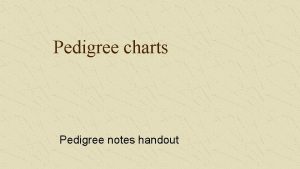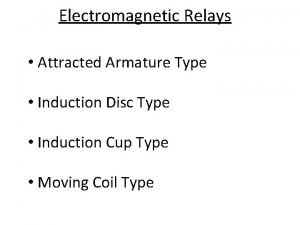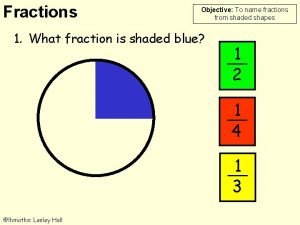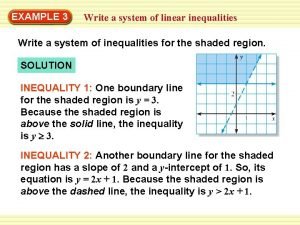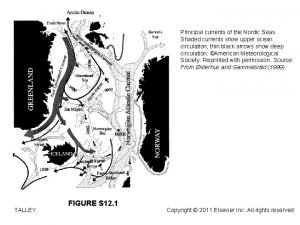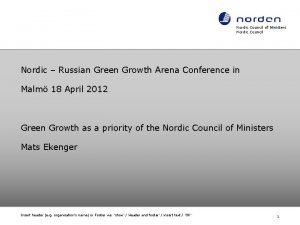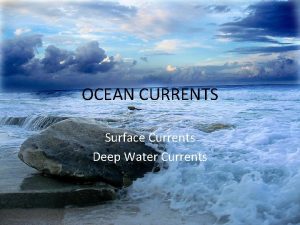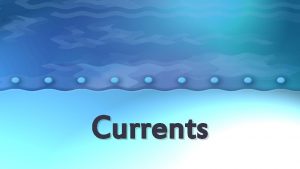Principal currents of the Nordic Seas Shaded currents











- Slides: 11

Principal currents of the Nordic Seas. Shaded currents show upper ocean circulation; thin black arrows show deep circulation. ©American Meteorological Society. Reprinted with permission. Source: From Østerhus and Gammelsrød (1999). TALLEY FIGURE S 12. 1 Copyright © 2011 Elsevier Inc. All rights reserved

Classical and recent structure of the Nordic Seas water column: (a) with deep convection and (b) with intermediate depth convection. PW, Polar Water; RAW, Return Atlantic Water; AODW, Arctic Ocean Deep Water; and NSDW, Norwegian Sea Deep Water. Source: From Ronski and Bude´us (2005 b). FIGURE S 12. 2 TALLEY Copyright © 2011 Elsevier Inc. All rights reserved

(a) Salinity, (b) potential density (kg/m 3), and (c) potential temperature (°C) sections at 75°N across the Greenland Sea “chimney. ” The last shows the whole section, while the first two are expanded views of the chimney itself. Source: From Wadhams, Holfort, Hansen, and Wilkinson (2002). FIGURE S 12. 3 TALLEY Copyright © 2011 Elsevier Inc. All rights reserved

Monthly mean Arctic sea ice motion from 1979– 2003 from Special Sensor Microwave Imager (SSM/I) passive microwave satellite data. Extended from Emery, Fowler, and Maslanik (1997); data from NSIDC (2008 a). FIGURE S 12. 4 TALLEY Copyright © 2011 Elsevier Inc. All rights reserved

Mean sea level pressure from ERA-15 and NCEP-NCAR reanalyses for (a) winter (December–February) and (b) summer (July–September) ©American Meteorological Society. Reprinted with permission. Source: From Bitz, Fyfe, and Flato (2002). FIGURE S 12. 5 TALLEY Copyright © 2011 Elsevier Inc. All rights reserved

(a) Potential temperature (°C), (b) salinity, and (c) potential density sq in the Eurasian Basin, with the Russian coast on the left and Lomonosov Ridge at the right. Source: From Schauer et al. (2002). FIGURE S 12. 6 TALLEY Copyright © 2011 Elsevier Inc. All rights reserved

Volume transport budget for the Nordic Seas. Source: From Hansen et al. (2008). FIGURE S 12. 7 TALLEY Copyright © 2011 Elsevier Inc. All rights reserved

(a) Winter (spring 1949) and (b) melting (spring 1950) sea ice in the Beaufort Sea. http: //www. photolib. noaa. gov/htmls/corp 1014. htm and http: //www. photolib. noaa. gov/htmls/corp 1104. htm (NOAA Photo Library, accessed 2009. ) (Photographer: Harley D. Nygren. ) FIGURE S 12. 8 TALLEY Copyright © 2011 Elsevier Inc. All rights reserved

Ice cover in the Barents Sea in early June 1994, using NASA AVHRR near-infrared imaging. Black indicates lack of ice (open water and polynyas). Source: From Anselme (1998). FIGURE S 12. 9 TALLEY Copyright © 2011 Elsevier Inc. All rights reserved

Kara Sea polynya distribution for January–April 2001. Light gray indicates land: Novaya Zemlya is at the bottom of the image. Dark gray is masked regions. Source: From Kern (2008). FIGURE S 12. 10 TALLEY Copyright © 2011 Elsevier Inc. All rights reserved

The Laptev Sea flaw polynya, imaged using Envisat advanced synthetic aperture radar, 1 May 2008. The polynya region is labeled as “new ice. ” Source: From Dmitrenko et al. (2010). FIGURE S 12. 11 TALLEY Copyright © 2011 Elsevier Inc. All rights reserved
 What is deep current
What is deep current What do the shaded shapes represent in a pedigree
What do the shaded shapes represent in a pedigree Find the area of shaded portion of the given figure.
Find the area of shaded portion of the given figure. Shaded pole relay
Shaded pole relay Ratio of shaded to unshaded squares
Ratio of shaded to unshaded squares 7 5 1 4 in fraction
7 5 1 4 in fraction Fraction shapes shaded
Fraction shapes shaded Shaded open square bullet (wingdings character code 113)
Shaded open square bullet (wingdings character code 113) What does the shaded organ refer to in the diagram below
What does the shaded organ refer to in the diagram below Find the area of the shaded sector
Find the area of the shaded sector In 1914 who controlled the shaded areas on the map
In 1914 who controlled the shaded areas on the map Examples of system of linear inequalities
Examples of system of linear inequalities

